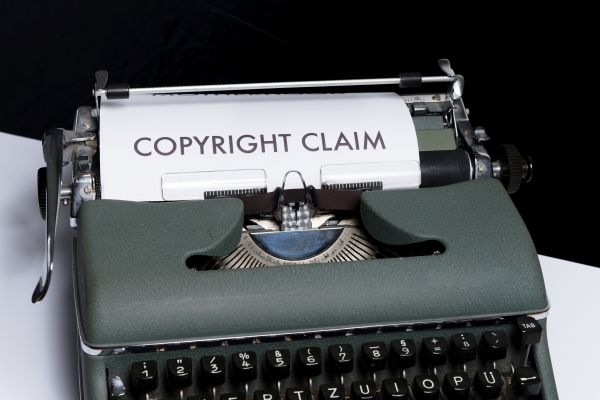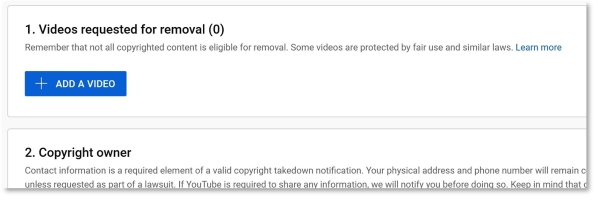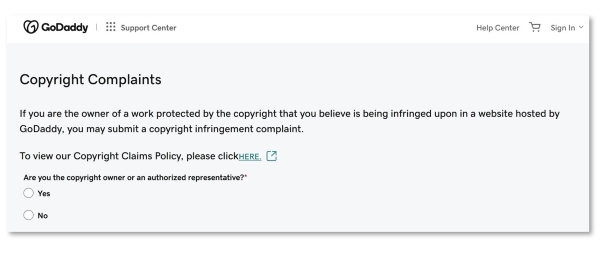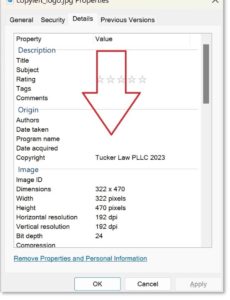
What is a DMCA Takedown?
A DMCA Takedown is a letter sent to a company asking them to remove a piece of content from a website because that content is copyrighted. These letters are also called “Takedown Notices,” “DMCA Takedown Notices”, or “DMCA Takedown Requests.” These are special letters that, when received by the website hosting the content, require that website to promptly remove the content from their website and notify the end user who posted it on the website that it was removed. Confusingly, the notice the website has to send to the end user who posted the infringing content is often itself called a “DMCA Takedown Notice” or “DMCA Notice.” For those of you who don’t know, this article: explains what it means for something to be copyrighted – you might want to give it a quick read before continuing.
When should I send a DMCA Takedown Request?
Whenever you find a site hosting content that you originally created you should consider sending a DMCA Takedown Notice as a first step; doing so does not preclude you from later on bringing a copyright infringement lawsuit, it simply quickly facilitates the removal of the content from the website. Just be sure the content itself is actually original and something you made and is protectable under U.S. copyright law. For example, you cannot copyright short phrases, simple designs, names, ideas (concepts), systems, or business methods. Learn more about what’s copyrightable.
What kind of content can you request be taken down in a DMCA Takedown?
Anything that’s copyrightable, including video, audio, code, script, text, and images.
What does DMCA stand for?
DMCA stands for Digital Millenium Copyright Act, a U.S. federal law enacted in 1998. Arguably the most important part of the DMCA was its creation of a streamlined workflow for websites and web platforms (like YouTube) to handle copyright infringement complaints.

How does the DMCA Takedown process work?
In a nutshell: (1) a DMCA Takedown Request is sent to the company hosting the website (e.g., HostGator) or the platform (e.g., GitHub or YouTube); (2) the company receiving the DMCA Takedown Request takes the content down and notifies the end user who posted it (often via email); (3) the end user who posted the allegedly-infringing content has an opportunity to send what’s called a DMCA Counter-Notice to the web host; (4) if no DMCA Counter-Notice is received, the webhost takes the content down, but if a DMCA Counter-Notice is received, the webhost notifies the original sender of the DMCA Takedown Request that the end user who posted the allegedly-infringing content disagrees that it’s protected by copyright; (5) the original sender of the DMCA Takedown Request has 14 days to file a lawsuit and, if they don’t, the webhost must replace the content (i.e., reverse the takedown). A lawsuit can still be filed at a later time, it just means that the allegedly-infringing content will be up on the website in the meantime.
How do you send a DMCA Takedown Request?
Trying to handle a DMCA Takedown yourself can be a major headache, especially if you’ve never done it before. How much is your time worth? Consider retaining the services of an attorney to solve the problem quickly and efficiently. That said, when you first find out that your stuff has been copied by some jerk on the internet, it’s understandable that you are angry and want to immediately spring into action. This can be a mistake because of the negative repercussions that can arise from incorrectly claiming copyright infringement, even if done so accidentally.
You first want to ensure that the content is copyrightable and that you are indeed the original author of the content. You’ll also want to ensure that you did not, accidentally or otherwise, provide others with the right to reuse your content, such as by posting your content on a site that hosts media under Creative Commons licenses. An attorney can help you with each of these preliminary analyses.
Once these initial steps have been completed, you’re ready to send the DMCA Takedown Request. There are two ways a DMCA Takedown Request can be submitted: (1) a written letter that is emailed or mailed to the webhost or (2) the submission of a special online form that has been made available by the webhost specifically for the purpose of receiving DMCA Takedown Requests. In both of these cases, chances are the webhost is going to take the DMCA Takedown Request more seriously if it’s coming from a law firm.

What information needs to go into a DMCA Takedown Request?
If the webhost has their own, online form for handling DMCA Takedown Requests the answer here is pretty simple: find the form and fill it out. That form is generally going to require you provide your contact information, identify the content on their site that you’re requesting be taken down, and agree to special legal provisions about your copyright ownership, along with an e-signature.
Alternatively, if the webhost does not have their own, online form for handling DMCA Takedown Requests then a letter will have to be emailed and/or mailed to the webhost. The Digital Millennium Copyright Act (7 U.S.C. § 512(c)(3)(A)) spells out very specific requirements for what has to be included in a DMCA Takedown Request, as follows:
(i) A physical or electronic signature of a person authorized to act on behalf of the owner of an exclusive right that is allegedly infringed.
(ii) Identification of the copyrighted work claimed to have been infringed, or, if multiple copyrighted works at a single online site are covered by a single notification, a representative list of such works at that site.
(iii) Identification of the material that is claimed to be infringing or to be the subject of infringing activity and that is to be removed or access to which is to be disabled, and information reasonably sufficient to permit the service provider to locate the material.
(iv) Information reasonably sufficient to permit the service provider to contact the complaining party, such as an address, telephone number, and, if available, an electronic mail address at which the complaining party may be contacted.
(v) A statement that the complaining party has a good faith belief that use of the material in the manner complained of is not authorized by the copyright owner, its agent, or the law.
(vi) A statement that the information in the notification is accurate, and under penalty of perjury, that the complaining party is authorized to act on behalf of the owner of an exclusive right that is allegedly infringed.

I submitted a DMCA Takedown Request, now what?
Now you wait. The webhost has to handle your DMCA Takedown Request promptly, but there is no specific deadline. You’ll usually get a response in a few days.
Can I get money from sending a DMCA Takedown Request?
No. Best-case outcome from a DMCA Takedown Request is that the webhost removes the copyright-infringing content from the website in question. To get money from the person who posted it originally, a demand letter would have to be sent or a lawsuit settled or won by an attorney on your behalf.
I received a notice from a website that my content has been taken down as a result of a DMCA Takedown Notice, what should I do?
What you should do depends on the facts. Did you actually post content that belongs to someone else? If so, you should do nothing, the content has already been removed. After doing nothing, consider educating yourself on the basics of copyright law and trademark law so you don’t end up infringing someone else’s intellectual property again in the future. A good place to start is with this Trademark Cheat Sheet Infographic; you’ll know the broad contours of trademark law in about 5 minutes.
Alright, but what if you truly believe the content you posted was not infringing someone else’s copyright? In that case I would strongly suggest you contact an attorney to explore your options because pushing the issue further without the proper preparation can result in your being sued for copyright infringement. That’s because sending a DMCA Counter-Notice starts the clock ticking for the other person – after receiving your DMCA Counter-Notice they have 14 days to file a lawsuit or the content will be restored to its original place by the webhost.

What’s a DMCA Counter-Notice?
Remember how the DMCA created this standard process for sending copyright infringement notices, so-called “DMCA Takedown Requests?” Well, the DMCA also created a standard process for disputing the validity of a DMCA Takedown Request. The process involves, again, sending a letter to the webhost that controls the website hosting the supposedly infringing content. In order for a DMCA Counter-Notice to be effective, it must contain all of the contents called for by the DMCA itself (7 U.S.C. § 512(g)(3)):
(A) A physical or electronic signature of the subscriber.
(B) Identification of the material that has been removed or to which access has been disabled and the location at which the material appeared before it was removed or access to it was disabled.
(C) A statement under penalty of perjury that the subscriber has a good faith belief that the material was removed or disabled as a result of mistake or misidentification of the material to be removed or disabled.
(D) The subscriber’s name, address, and telephone number, and a statement that the subscriber consents to the jurisdiction of Federal District Court for the judicial district in which the address is located, or if the subscriber’s address is outside of the United States, for any judicial district in which the service provider may be found, and that the subscriber will accept service of process from the person who provided notification under subsection (c)(1)(C) or an agent of such person.

How do I know who DMCA Takedown Requests should be sent to?
Some of you might read this question and think, “Isn’t it obvious? I found some content infringing my copyright on YouTube and therefore I should send the DMCA Takedown Request to YouTube.” And you’re exactly right. But what if you find copyright-infringing content on some random website, like a blog? What then? In that case, the DMCA Takedown Request should be sent, not to the person or company who copied your content in violation of your copyright, but to the company they hired to host their website. Common webhosts include HostGator, GoDaddy, and DreamHost.
If the copyright-infringing content isn’t hosted on a famous platform like YouTube, how do I figure out who to send the DMCA Takedown Request to?
You can find out what company is hosting any given website by performing a WHOIS Lookup on ICANN’s website. When you use that tool, oftentimes you will see the names of multiple different companies in the results. While it’s easy for me to determine which to send it to, if you’ve never done it before and are hell-bent on DIYing this project, I would suggest simply Googling “[name of company] DMCA Takedown” for each of the named companies and following their standard processes. For example, doing that for HostGator will land me on their DMCA Takedown procedure webpage and it’s as simple as following the directions from there on out.

How can I prevent other people from stealing my content and posting it as their own?
This is a subject for another article as it deserves a thorough response, but let’s summarize. First principles: it’s impossible to stop someone from stealing your image or video if you’ve made it publicly-available. If someone wants to take your stuff, law-be-damned, they can physically do so (in the case of an online image, for example: mouse right-click > Save Image As > voila!). So when we talk about prevention of copyright infringement, it’s important to understand that we can do things to minimize its frequency and scope, but truly eliminating the possibility would require some sort of technical solution that doesn’t currently exist.
For images, a watermark of your brand, a copyright symbol superimposed on the image itself, and adding copyright metadata to the file before posting it are all viable options (in Windows, right-click > properties > details > add metadata) for minimizing the occurrence of people stealing your content.
For video, a watermark of your brand in the lower corner is your best option, and YouTube even has built-in functionality that facilitates your doing this (in your Channel Settings > Branding > Video Watermark) so you don’t have to do it manually during the video creation and editing process. YMMV for other video platforms.

How do copyright symbols, copyright notices, or branding help prevent copyright infringement?
Both copyright symbols, copyright notices, and branding are all indicia of an owner/creator who knows their rights and takes what they are doing seriously. It sends a message to a would-be infringer that you “don’t play.” Copyright symbols and notices serve other purposes to, but that’s a subject for a different article.
What if someone is just harassing me with DMCA Takedown Requests that they know are bogus?
Unfortunately, this happens all the time. Technically, if the person or company sending false DMCA Takedown Requests doesn’t actually own the copyright in the content they’re complaining about, they are guilty of the crime of perjury, a felony under federal law – super no bueno. That said, this is an uncommon occurrence.
The much more common scenario is that the person or company complaining does hold the copyright in the content, but their complaint is bogus because they failed to perform what’s called a Fair Use analysis prior to submitting their DMCA Takedown Request. Fair Use is a legal doctrine under U.S. law that deserves its own article. If you’re bored or you just like nerding out on copyright law, you can read all about Prince’s lawsuit over the use of a portion of Let’s go Crazy in a YouTube video.
This sounds a bit complicated and I’m short on time, can I just hire someone to do this for me?
Absolutely, we have plenty of experience getting copyright-infringing content removed from the internet. Please reach out to us for a free consultation and we can discuss your situation and options.